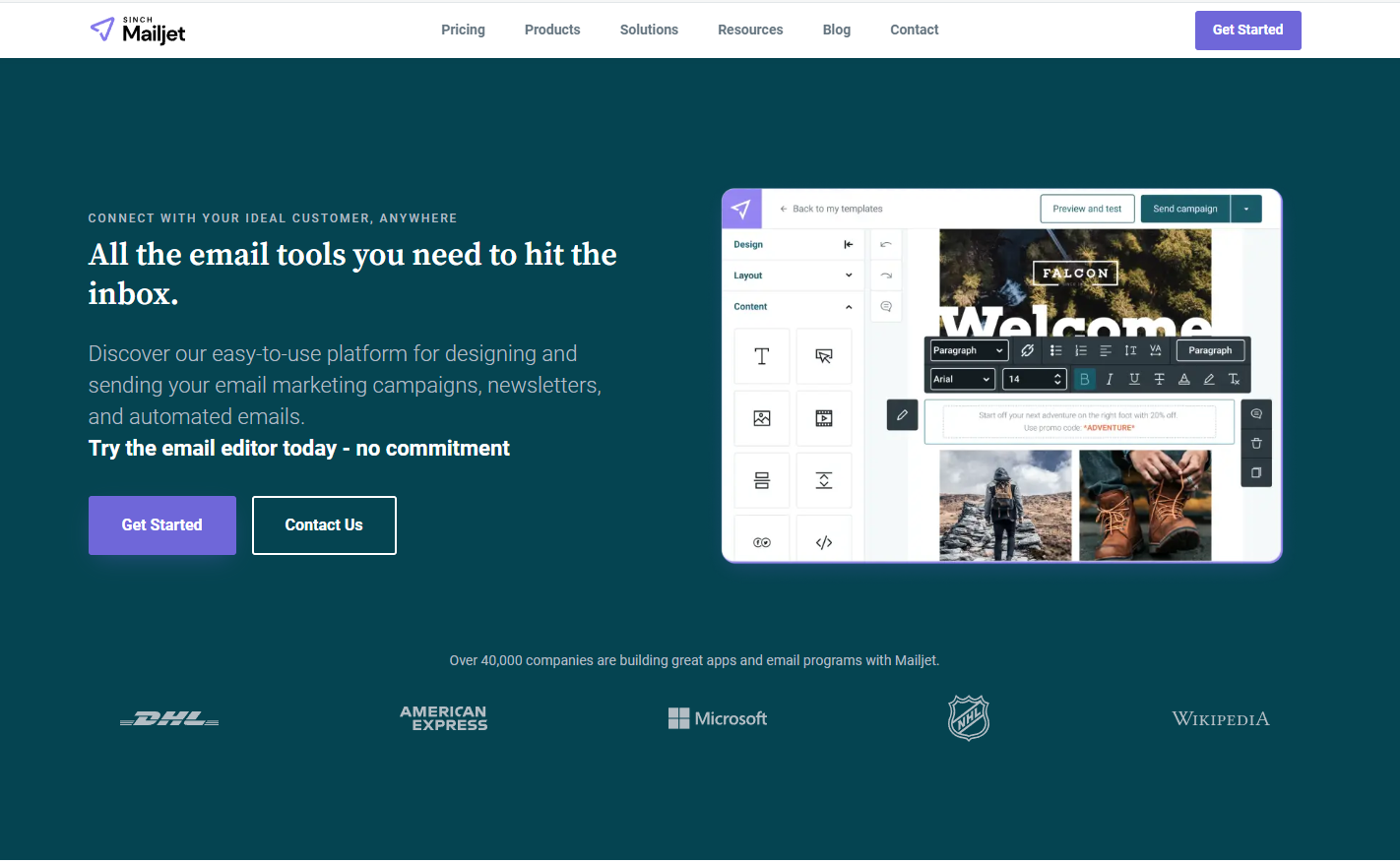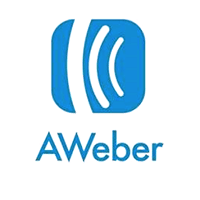MailerLite is one of the most popular email marketing platforms, used by over 1 million businesses and entrepreneurs. It provides an easy-to-use solution for creating, sending, and tracking email newsletters, promotions, broadcasts, and automation.
However, it’s not the best platform for everyone and if you’re in the same boat, this compilation of MailerLite alternatives should help you pick a great option.
Brevo
With more than 99% email deliverability and some powerful automation tools, Brevo is the best MailerLite alternative
Omnisend
Omnisend is an excellent option for eCommerce-focused brands that want to enhance their overall email marketing efforts
HubSpot
Use HubSpot's advanced A/B testing capabilities to determine which campaigns are most effective for inbound marketing
Active Campaign
ActiveCampaign is a flexible and efficient choice for small and medium-sized businesses that want to grow their campaigns
AWeber
AWeber is a popular MailerLite alternative due to its inherent ease of use that even beginners can easily utilize to its max potential
1. Brevo
Best Overall MailerLite Alternative (Free, then $25/Month)
Brevo is a relative newcomer to the email marketing space that has quickly made a name for itself. It focuses specifically on serving the needs of small businesses with limited budgets but big ambitions when it comes to professional digital marketing capabilities.
Key features include a beautiful email template builder, advanced automation workflows, subscriber management tools, detailed analytics, and easy integration with top business software platforms.
What makes Brevo a better alternative than MailerLite:
- No subscriber limits, even on basic paid plans
- More advanced segmentation for hyper-targeted campaigns
- Built-in e-commerce integration and tracking
- Automation workflows with unlimited steps and conditional logic
- Expanded design options and custom CSS for complete template control
Unlike MailerLite, Brevo does not impose annoying restrictions on how many contacts you can have or emails you can send at basic paid tiers. It also facilitates much more sophisticated list segmentation for personalized messaging to micro-groups within your audience.
For e-commerce brands, native integration with popular platforms like Shopify makes tracking sales and automating customer journeys easy. Highly flexible automation workflows help you create multi-branched campaigns to nurture subscribers based on their behaviors and attributes. Lastly, Brevo gives full design control with hundreds of templates and the ability to write custom CSS when needed.
2. Omnisend
Best for E-Commerce Brands (Free, Then $16/Month)
Omnisend is an email and SMS marketing platform built specifically to enable e-commerce merchants to grow their customer base and increase repeat sales.
It seamlessly integrates with all major shopping carts to connect email and messaging efforts directly to purchase behavior and website activity. Notable features include powerful automation based on lifecycle stage, granular customer segmentation, personalized campaign creation, and in-depth e-commerce analytics.
What makes Omnisend a better alternative than MailerLite:
- Deep integration with shopping carts for customer sync and sales tracking
- Automated post-purchase and browsing abandonment workflows
- Advanced subscriber segmentation by purchase history and LTV
- Dynamic content blocks in emails for personalization
- Robust e-commerce analytics on revenue driven by campaigns
Omnisend stands out from MailerLite in its e-commerce focus and specialization. It auto-syncs all customer data from connected shopping carts and makes this information actionable through its segmentation and automation tools.
You can easily set up workflows triggered by cart abandonment or post-purchase activity and leverage subscriber order history to segment and personalize messaging. Omnisend also provides clear analytics linking email and SMS campaigns to online sales, helping you double down on what’s working.
3. HubSpot
Best for Inbound Marketing Strategies (Free, Then $20/Month)
HubSpot aims to be an integrated CRM (customer relationship management) and marketing software solution tailored for companies embracing inbound principles.
It brings together email and landing page creation, lead management, contact databases, analytics, and other tools on one powerful platform. With robust segmentation, automation, and integration capabilities, HubSpot gives businesses a complete view of their prospects and customers in one dashboard.
What makes HubSpot a better alternative than MailerLite:
- Unified customer data and insights across departments
- Lead scoring and routing functions to prioritize sales prospecting
- A/B testing for emails, and landing pages to optimize performance
- Expanded analytics on audience engagement across channels
- Easy integration with webinars, meeting tools, and external apps
Unlike the exclusively email-focused MailerLite, HubSpot links email efforts to a broader inbound strategy and wider business operations.
Its unified database centralizes prospect and customer information to inform email targeting while built-in A/B testing capabilities enable continuous optimization. More granular analytics provide greater visibility into multi-channel engagement, and there’s easy integration and smooth alignment of email with other critical systems.
4. ActiveCampaign
Best for Small to Medium Businesses ($29/Month)
ActiveCampaign markets itself as an all-in-one customer experience automation platform designed with small to midsize businesses in mind. It brings together email marketing, sales automation, messaging, site tracking, and other capabilities on one integrated platform. Signature features include 500+ pre-built automation, advanced segmentation tools, personalized customer journeys, and rich analytics.
What makes ActiveCampaign a better alternative than MailerLite:
- Custom automation workflows without coding
- Expanded segmentation by behaviors, scores, and tags
- Tools to track site visitors for targeted follow-up
- Integration with other martech systems
- Detailed analytics on automation and campaigns
Unlike MailerLite’s more constrained automation builder, ActiveCampaign enables users to create complex multi-branch sequences without any coding know-how.
It facilitates more advanced segmentation to cohorts by behaviors, lead scores, and custom tags for hyper-personalization. Built-in site tracking and visitor identification further inform email targeting efforts. With Zapier integration along with native CRM and other functionalities, ActiveCampaign acts as a true customer experience hub.
5. AWeber
Best for Ease of Use (Free, Then $12.50/Month)
AWeber is one of the more established email marketing platforms aimed at serving solopreneurs, side hustlers, and small teams with intuitive tools to grow their audience. Notable features include drag-and-drop email design, signup forms and landing pages, broadcast schedules, basic automation, and integration with many popular third-party apps.
What makes AWeber a better alternative than MailerLite:
- No limits on subscribers or emails sent per month, even at lower price points
- Visually editable signup forms and landing pages to capture more leads
- Over 700 app integrations vs. MailerLite’s 185 third-party apps
- Extensive deliverability course curriculum for beginners
- Phone, chat, and email support provided by US-based consultants
One major limitation many encounter with MailerLite is its free plan subscriber and email caps, which force upgrades after a certain threshold no matter the cost appetite. AWeber eliminates these thresholds, allowing unlimited contacting at even its entry-level tiers. Coming from a list size restriction can be liberating.
AWeber also provides more advanced tools for creating customized signup forms, embedded lead captures, Welcome mats, and multi-page HTML landing pages – leveraging clear templates and point-and-click editing. This enables less tech-savvy users to easily construct conversion funnels driving email list growth.
While MailerLite relies solely on Zapier for tools integration, AWeber hand-selects and deeply integrates over 700 apps covering analytics, surveys, webinars, e-commerce, and more. This saves users hassle when syncing key platforms to their email database.
For those needing assistance with deliverability or strategy, AWeber supplies actionable educational courses and US-based support teams available by phone, chat, and email.
6. Campaigner
Best for Advanced Email Marketing and Automation ($59/Month)
Campaigner markets itself as a premium email marketing platform built for more sophisticated users with complex workflows and large subscriber lists. Key capabilities span customizable drag-and-drop builders, deep analytics, advanced automation, API integrations, dedicated IP addresses, and more.
What makes Campaigner a better alternative than MailerLite:
- Automation based on open, click tracking data
- Custom coding and CSS control options
- Tools to manage subscriber engagement scoring
- High level of segmentation functionality
- Compliance features like granular opt-out settings
With Campaigner, users gain access to more customized automation based on open and click tracking data not available in MailerLite at basic tiers. Developing complex, multi-prong triggers and filters for unique cohorts is also easier. Users can leverage much more fine-tuned subscriber scoring to hyper-personalize content improving engagement.
On design, while MailerLite templates are sufficient for some, Campaigner allows more branding and layout control with custom code implementation when desired. For regulated industries, strong opt-out tools, consent management, and address verification promote deliverability.
7. BigMailer
Best for High-Volume Email Senders (Free, Then $5/Month)
BigMailer markets itself as an elite email marketing platform built to meet the needs of companies sending millions of emails per month. It provides specialist tools and infrastructure for ensuring strong inbox placement and engagement rates at scale, along with high-performance automation, segmentation, analytics, and more.
What makes BigMailer a better alternative than MailerLite:
- Dedicated IP reputations for each customer
- Deliverability monitoring and optimization
- Contact-level engagement analysis
- Dynamic content for personalization
- High sending capacity per month
With MailerLite, those sending large volumes can risk hitting sending limits or having IP reputations damaged by other customers on shared infrastructure. BigMailer provides dedicated IPs for each brand ensuring independent deliverability not tied to the actions of others.
It also supplies advanced engagement analytics to optimize outreach on a per-subscriber basis along with ongoing reputation monitoring. Users gain more sophisticated personalization capabilities by leveraging dynamic content. And for simply managing list size, entry-level plans permit vastly higher sends per month than MailerLite.
8. Constant Contact
Best for Startups (Free Trial, Then $12/Month)
Constant Contact is a long-standing email marketing solution built specifically for the needs of small businesses and entrepreneurs. It focuses on providing an intuitive drag-and-drop builder, professional templates, an automated welcome series, and seamless integration with Constant Contact’s suite of marketing tools covering websites, logos, listings management, and more.
What makes Constant Contact a better alternative than MailerLite:
- Tight integration with complementary marketing services
- Multi-channel customer engagement perspective
- Library of marketing advice and best practice content
- lead capture forms and landing pages
- Excellent onboarding, setup, and support
Unlike MailerLite’s singular email focus, Constant Contact links email to a wider array of marketing services for streamlining efforts and increasing visibility. These include website builder, Google listing tools, next-generation digital storefronts, logo creation, live chat capabilities, and more.
For those less fluent in digital marketing, Constant Contact also supplies an extensive knowledge base and award-winning customer support. From capturing leads to driving traffic to measuring results, Constant Contact provides unified data and insight.
9. GetResponse
Best for Powerful Analytics and Flexible Automation (Free, Then $15.60/Month)
GetResponse markets itself as an easy-to-use email marketing solution built for small to midsize teams looking to create, send, and track professional marketing campaigns. Key features include customizable forms and landing pages, a drag-and-drop email builder, advanced automation based on user behaviors, and integrated analytics to inform strategy.
What makes GetResponse a better alternative than MailerLite:
- Automation based on detailed user engagement data
- Superior analytics and custom goal/KPI tracking
- Improved deliverability through dedicated IPs
- Easy integration with webinars, surveys, and other content
- Generous sending limits even at the lowest pricing tier
Unlike MailerLite’s basic engagement tracking, GetResponse collects granular data on subscriber clicks, browsing, cart activity, and more to trigger hyper-targeted sequences. Users also gain access to deeper analytics functionality helping to set and monitor the performance of email campaigns against custom goals.
Features like dedicated IPs per account, along with in-depth traffic source analysis improve inbox placement. Native integrations with webinars, surveys, and other content smoothly expand beyond basic email newsletters when desired.
10. Mailjet
Best for Scaling (Free Plan, Then $15/Month)

Mailjet markets itself as an advanced email marketing solution made for demanding users with sophisticated workflows and large, complex contact databases. Key strengths focus on scalability, customization, deliverability at scale, granular segmentation capabilities, and excellent integration with CRMs/databases for real-time synchronization.
What makes Mailjet a better alternative than MailerLite:
- Contact scoring and dynamic attribute tagging capabilities
- Superior deliverability with dedicated IPs
- Real-time database synchronization
- Advanced tools for managing subscriber engagement
- The high degree of customization in templates, layouts
For enterprises with big growth ambitions, MailerLite can start restricting options and performance in ways Mailjet is built to power through over the long term. Mailjet makes it easy to segment users based on time-sensitive behaviors or scores calculated from criteria users define for accurate grouping and messaging personalization.
Dedicated IPs also ensure strong inbox placement at higher volumes. And with CRM, ERP, and database sync support teams can make the most of external live data within campaigns. Extensive template editing and custom CSS empower complete brand control.
11. Mailchimp
Best for Simple but Efficient Email Marketing (Free, then $10/month)
Perhaps the most well-known email marketing platform, Mailchimp powers marketing efforts for over 15 million businesses globally. It focuses squarely on ease of use delivering features like customizable templates, drag-and-drop builder, email automation, basic landing pages/forms, audience management tools, and clear campaign/subscriber analytics.
What makes Mailchimp a better alternative than MailerLite:
- Flexible automation based on any data point
- Superior insight into audience engagement
- Easy sync with e-commerce platforms like Shopify
- Ability to have sub-accounts and collaborative teams
- Strong educational resources for beginners
Unlike MailerLite’s constrained automated triggers, Mailchimp gives brands the flexibility to trigger workflows based on any user data point or activity whether that’s purchase frequency, completed profile info, clicked links in a newsletter series, and more for hyper-targeted sequences.
For optimizing emails themselves, MailChimp provides superior analytics detailing open, clickthrough, and block rates. For e-commerce merchants, seamless Shopify integration eliminates painful manual syncing.
With group access permissions, teams can also easily collaborate across accounts and integrate efforts. And for those newer to sophisticated email, Mailchimp offers fantastic learning materials and support content.
Features to Consider For a MailerLite Alternative
1. Ease of Use
Ease of use should be a top consideration when evaluating alternatives to MailerLite or any email service because the platform needs to be intuitive enough for non-technical users to pick up and implement campaigns without major learning curves or reliance on developers.
The beauty of MailerLite is it has a straightforward interface, drag-and-drop builder, and workflow creation tools accessible for beginners. More advanced solutions often sacrifice some user-friendliness for expanded functionality. But with the right platform, both power and simplicity can coexist.
Look for an email marketing service with an interface that is clean and navigable, with key features easy to locate. Make sure core tools like template design, automation setup, and contact management don’t require coding skills or consulting help to leverage.
See if the provider offers guided onboarding content, webinars, or video tutorials to ramp up quickly on the platform. Prioritizing ease of use helps ensure your team can make the most of the solution.
2. Design and Customization
The ability to craft professional, branded email templates that reflect your company’s unique style and voice is pivotal for engagement and performance. You want to make sure any MailerLite alternative provides ample design control and customization capabilities.
While MailerLite offers some nice starter templates, they tend to look generic, and custom CSS skills are required to substantially modify layouts beyond picking a color scheme or uploading a logo. More advanced platforms let you directly edit template source code or leverage a visual editor to customize modules for faster tweaking without coding expertise.
Look for a email marketing tools with a wide variety of mobile-optimized templates to choose from covering common use cases. Make sure you can directly insert images, rearrange content blocks, alter colors, fonts, and other stylistic elements with ease.
And see what abilities exist for saving customized templates, creating layout variations for A/B testing, and establishing brand consistency across campaigns. Prioritizing design and customization flexibility helps ensure your message resonates.
3. Blogging Tools
The ability to directly publish and promote blog content inside your email marketing platform streamlines subscriber engagement efforts. Rather than relying solely on external blogging platforms and trying to drive traffic back to signups, look for solutions allowing integrated content creation.
MailerLite currently does not offer any native blogging or web hosting capabilities. This means you need to manage your blog separately, and then manually copy/paste content into MailerLite emails or campaign landing pages while embedding any images or media files. This disjointed workflow creates extra steps tying email to blogging.
Ideal email provider alternatives give you built-in content authoring abilities within the same interface used for email creation and automation.
This means directly drafting blog posts for syndication to both external websites as well as email newsletters and subscriber pages. Integrated blogging smoothes audience expansion by eliminating friction in repurposing content while associating your brand’s thought leadership.
4. E-commerce Capabilities
For online merchants, finding an email marketing platform capable of integrating with your e-commerce store is critical. You want advanced features, including customer and order data that flows seamlessly to inform personalized communications driving repeat business.
Currently, MailerLite has no native e-commerce features. This forces users to manually export subscriber lists and campaign results to sync email efforts with a separate shopping cart platform. Without tight e-commerce ties, leveraging purchase behavior and shopping cart activity for relevant segmentation and enriching subscriber profiles becomes extremely difficult.
Look for email marketing services that can auto-sync customer information bi-directionally with leading commerce platforms like Shopify, WooCommerce, BigCommerce, etc. Automatic data exchange saves manual exporting or structuring of subscriber attributes based on orders.
Robust e-commerce integrations also enable tracking online revenue driven by email campaigns, automating post-purchase review requests or reorder reminders, and creating workflows for win-back or browse abandonment scenarios. Prioritizing commerce-ready capabilities ensures messaging relevance.
5. SEO Tools
Embedding email campaigns into broader SEO strategies is pivotal for driving organic traffic and discovery. When evaluating email providers, check if basic search optimization features are natively supported or accessible through integrations.
Currently, MailerLite offers no built-in SEO capabilities. This makes optimizing campaign landing pages for keywords difficult without custom coding skills or leveraging external site plugins. Lacking SEO controls also provides less content to index for search engines.
Ideal alternatives facilitate built-in SEO management or extensions allowing easy metadata customization, page URL rewriting, alt text additions to images, site indexing allowances, and sitemap generation for better bot crawling. Robust SEO handling helps boost visibility for both landing pages as well as the emailed content itself.
Prioritizing platforms with strong search optimization tools or compatibility with SEO plugins allows users better synergy between email campaigns, website optimization efforts, and organic list growth ungated by paid advertising. Treatment of email content mirrors that of any web page copy when it comes to boosting discovery and targeting rankings.
6. Integrations
The ability to connect your email marketing platform to other business systems and software maximizes results and efficiently coordinates wider efforts. Assessing the native and third-party integrations an alternative solution offers ensures extensibility as your needs grow.
Currently, MailerLite relies solely on Zapier for any integrations with external tools outside basic social media sharing. This forces users to stitch together connections through the third-party service rather than leverage more turnkey, embedded integrations.
Ideal alternatives offer a generous array of native integrations with complementary systems like analytics, surveys, webinar software, e-commerce platforms, and CRMs for enrichment of your email marketing efforts. They also ideally integrate smoothly with Zapier and API options for connecting specialized tools when required.
The more integrated connections your email marketing tool has, the easier it becomes to track email performance effects into sales, scale webinar promotion, personalize outreach based on survey feedback, and feed campaign engagement data into your master customer records for informed messaging.
Prioritizing platforms with robust integrations or extensibility avoids data silos and synchronization hassles.
7. Analytics and Reporting
Robust analytics and reporting capabilities are essential for continuously optimizing campaigns and demonstrating email marketing ROI. More advanced alternatives to MailerLite provide expanded insight into subscriber engagement along with tools to quantify business impact.
MailerLite’s basic analytics supply open, click, and unsubscribe rates. However, they lack enriching behavioral data on subscriber website browsing, link clicks, and share statistics that inform segmentation and personalization. Conversion tracking is also manual requiring custom coding skills vs turnkey tools.
The best alternative platforms provide holistic visibility incorporating granular metrics from across channels and integrated platforms. This means seeing which email content drives site traffic, and social shares, which links get the most love, who converts to online courses or webinars, and more. Automated reporting also saves users from manually pulling reports tied to key objectives.
Prioritizing more powerful analytics allows you to spot trends, react quickly if deliverability suffers, and optimize copy length or promotional placements as you learn more about audience preferences.
Robust analytics help connect consumer behaviors from email engagement directly to business KPIs for quantifying program effects. Continuous optimization and strategic decision-making require strong instrumentation.
8. Customer Support and Community
Having access to stellar customer support and an engaged user community when questions arise is pivotal for any software experience. When choosing an alternative platform, make sure sufficient resources exist to smooth onboarding and ongoing education.
Currently, MailerLite offers email-based support along with some community forums. However hands-on training or real-time assistance common in more premium solutions is lacking. This can slow adoption or growth for less experienced email marketers.
Ideally, alternate providers facilitate multiple support access channels spanning self-help content, chat, phone assistance, and email covering basics to advanced tactics. There should also be community forums enabling users to interact, and post questions for peer advice. Some even offer live meetups and events.
Prioritizing alternatives with strong customer support builds user confidence in sending high-volume communications and reduces anxiety over making mistakes. And an engaged community creates opportunities to continually expand your skills through proven email marketing strategies from other members.
With email marketing, learning never stops as techniques evolve so surround yourself with knowledgeable resources.
9. Pricing
Email marketing platforms vary widely in terms of monthly fees depending on features, scale, and intended use cases. When evaluating an alternative provider, analyze both short and long-term costs to ensure alignment with budget and growth plans.
A major advantage of MailerLite is offering a perpetually free tier covering core features, although capped at certain thresholds. Many competing solutions start paid plans once contacts or email volumes exceed limits.
Ideally, alternate providers maintain a forever free offering similar to MailerLite allowing basic functionality even for larger audiences. For paid upgrades, look for flexible scaling without large jumps at tier thresholds that may spur constant churn.
If pursuing aggressive subscriber acquisition, calculate total costs associated with desired contacting volumes and engagement-driven automation.
Balancing financials with functionality encourages finding an email platform able to cost-effectively grow over time with your business. So when comparing alternatives, model out upside scenarios across pricing packages along with transparency into overage penalties or add-on fees that may surprise budgets down the road.
10. Reviews and Reputation
The reputation and validating social proof associated with an email provider informs the trust you can place in their services and stability as a technology partner over time. As part of due diligence selecting alternatives means analyzing credible reviews and community feedback.
As a popular platform, MailerLite garners lots of consumer reviews sharing common pros around ease of use along with limitations acknowledged around advancing automation, analytics, and scalability needs. Feedback highlights room for growth better addressed by other solutions.
Vet any alternative platforms across trusted directories like G2, Capterra, and Software Advice highlighting real customer experiences with the tools.
Look for recurring satisfaction with reliability, deliverability, and support response in facilitating complex workflows and expanding subscriber volumes. Case studies from customers in your industry also validate effectiveness.
While no platform is perfect across all evaluation criteria, prioritizing those with largely positive reputation signals based on transparent customer commentary builds confidence in transitioning from MailerLite’s entry-level capabilities while still focusing on core email marketing use cases most important to your growth.
Summary and Top Picks
In this blog post, we have extensively reviewed a variety of capable alternatives to the popular email marketing platform MailerLite. While MailerLite offers an easy-to-use solution for basic email newsletters, automation, and subscriber management, many users eventually seek more sophisticated features as their needs grow.
We analyzed highly-rated competitor solutions across several categories – ease of use, design and customization, blogging abilities, e-commerce integrations, analytics, customer support, reputation, and more. Our goal was to determine offerings best positioned to help small businesses level up their capabilities at affordable price points for sustainable growth.
The table below shows my top five MailerLite alternatives based on standout features, customer validation, and ability to scale from initial startup needs through enterprise deployments:
Brevo
With more than 99% email deliverability and some powerful automation tools, Brevo is the best MailerLite alternative
Omnisend
Omnisend is an excellent option for eCommerce-focused brands that want to enhance their overall email marketing efforts
HubSpot
Use HubSpot's advanced A/B testing capabilities to determine which campaigns are most effective for inbound marketing
Active Campaign
ActiveCampaign is a flexible and efficient choice for small and medium-sized businesses that want to grow their campaigns
AWeber
AWeber is a popular MailerLite alternative due to its inherent ease of use that even beginners can easily utilize to its max potential





